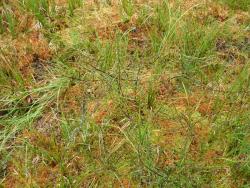- Taxon
- Gallery
Semi-erect to prostrate, shortly rhizomatous, evergreen, dioecious, trailing shrub up to 0.5–1 m tall × 2–6(–8) m wide. Main stems usually two or more, up to 40 mm diam., arising from a dense network of both lateral roots, buried stems and/or short-rhizomes; branches numerous, wiry, slender, somewhat lianoid, longtrailing up to 10 mm diam., arising at angles of > 45°, frequently rooting at nodes. Mature outer bark rustbrown or maroon-brown, usually smooth but becoming finely fissured and longitudinally cracked with age, persistent. Bark sometimes shedding in circular flakes; inner bark when exposed lime-green to green-yellow. Juvenile shoots slender c. 1 mm diam., ± terete, initially pale brown to cream, maturing rust-brown to almost purple-black, densely clothed in minute white, eglandular, retrorse to patent, 0.1–0.3 mm long hairs. Brachyblasts numerous and very leafy, initiating at apex of penultimate flush with expanded leaves ultimately, the rest of brachyblast clothed in stipules; internodes 0.1–0.2 mm, scarcely visible, being ± obscured by leaves and/or stipules. Leaves opposite, densely clustered on short shoots, linear-filiform, coriaceous; petioles scarcely differentiated from lamina; lamina strap-like, often falcate, 0.2–0.5 mm long, crimson or dark green, (4–)10(–30) × (0.3–)0.6(–1.2) mm, margins involute, smoothly rounded and strongly recurved when dry, apex obtuse, base attenuate. Leaf colour variable with distinct colour forms present in most populations, the common form wine-red, other morphs light green or dark green with red margins, red colour morphs also tending to have more heavily pigmented fruit, adaxial surface finely to copiously covered in patent, deciduous eglandular hairs (40× magnification), if copiously hairy then hairs imparting a grey downy appearance to leaf lamina; leaf domatia common, 1–3 per leaf when present; midrib scarcely evident, primary lateral veins 1–3, inconspicuous and lacking secondary divisions. Interpetiolar stipules 0.3–0.6 mm long, orangebrown or purple, shortly sheathing, sheath < 1⁄4 length of stipule and apical denticle, narrowly triangular, marginal fringe chartaceous, dark abaxial surface heavily invested in white hairs, antrorse, patent, retrorse or mixes of these 0.1–0.5 mm long; margin of stipules entire; denticles (3–)5(–6), glandular, black, deciduous; with 1–2 at apex of stipule, and (1–)3(–4) on stipule sheath, these confined to the margin of sheath midway between stipule apex and leaf base. Plants unisexual; flowers subsessile, axillary, solitary or paired in uppermost leaves of previous growth flush. Pedicel minute. Flower subtended by pair of highly reduced, bract-like leaves 0.1–0.5 mm long, and their stipules; orangebrown to dark brown or purple; thickly invested in antrorse, white hairs. Male flowers larger and more numerous than female flowers, and in pairs or triplets, rarely solitary; calyx vestigial; corolla 5– 6 mm long; tube 1.5–2 mm long, funnelform, pale yellow copiously flecked with red or pink; lobes 3– 4, opening to half length of tube, broadly elliptic or lanceolate, 4.5–5 × 1.6–1.8 mm, recurved, minutely papillose at apex and on inside; filaments 4–6 mm long, cream, papillate; anthers 3–4, 2.5–3 × 1– 1.5 mm, oblong, dorsifixed, 2-locular, apex acute or attenuated, papillose; pollen creamy yellow. Female flowers solitary, rarely paired; calyx adnate to ovary, pale yellow flecked crimson or pink, often with a pale gland between the calyx lobes, lobes 4, 0.75– 1 mm long, obovate to oblanceolate, basal portion pale yellow flecked with red fading to pale yellow in upper portion, margins glabrous, otherwise abaxial surface finely covered in white eglandular hairs; corolla tube 2–2.5 mm long, narrowly campanulate, yellow, striped and/or flecked red, especially toward distil portion; lobes 3–4, opening to 3⁄4 length of tube, linear-lanceolate to lanceolate 2.5–3 × 0.6 mm, strongly decurved, minutely papillose at apex and on the inside; ovary ovoid, green, 0.8–1 × 0.6–0.8 mm, 2-locular; stigmas 2, 8–14 mm long, terete, pale yellow to cream, densely papillose-pubescent; stigmatic hairs 0.1 mm long, white. Drupe ellipsoid topped by a persistent calyx, 4–6 × 3–4 mm, epicarp white stippled with dark blue flecks (rarely entirely dark navy blue), mesocarp gelatinous, translucent and unpigmented. Pyrenes (1–)2, unequal; when two, then the larger (2.5–)3.0(– 4.5) × 1.8–2.5 mm, ovoid to ellipsoid, plano-convex, apex obtuse, rarely acute; base obtuse to acute; ± smooth, dorsal surface sometimes with a low median ridge in the upper 1⁄3–1⁄2 of pyrene; operculum distinct, occupying c. 1⁄3–1⁄2 of pyrene surface, obovate-obtriangular; somewhat tuberculate or otherwise smooth. FL Oct–Nov; FR Mar–Jul.
[Reproduced from Markey & de Lange (2003, New Zealand J. Bot. 41: 459-473) with permission from The Royal Society of New Zealand.]




